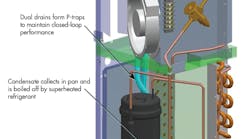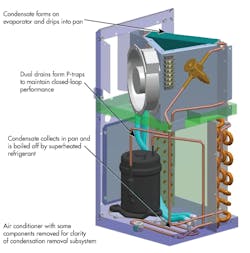This file type includes high resolution graphics and schematics when applicable.
Condensation and electricity are a potentially deadly mix because moisture increases the dangers of electric shock. Condensation can also corrode and damage electrical equipment. That’s why it’s essential that humidity inside electrical enclosures is removed. Traditional methods of removing the resulting condensate are not particularly effective and may lead to water spills if poorly installed. This increases the risk of people falling when walking on a wet floor near the electrical enclosure.
That’s why engineers at Thermal Edge Inc. developed a condensate control subsystem that is standard on all its electrical enclosure air conditioners. The subsystem routes copper tubing containing hot refrigerant gas through a condensate boil-off pan. The pan is ahead of the condenser and in the hottest point in the refrigerant system where gas temperatures range from 180° to 260°F.
Condensate evaporates and the vapor is discharged by the condenser blower to the environment. Additionally, the condensate evaporation helps pre-cool the hot gas, lowering the power (running amps) needed and making the enclosure air conditioners more energy efficient.
The boil-off pan can store enough water to dehydrate the air in the equipment enclosure and vent it off without overflow so long as the enclosure doors are closed. If the enclosure remains open without turning off the air conditioner, the manufacturer supplies an overflow fitting.



